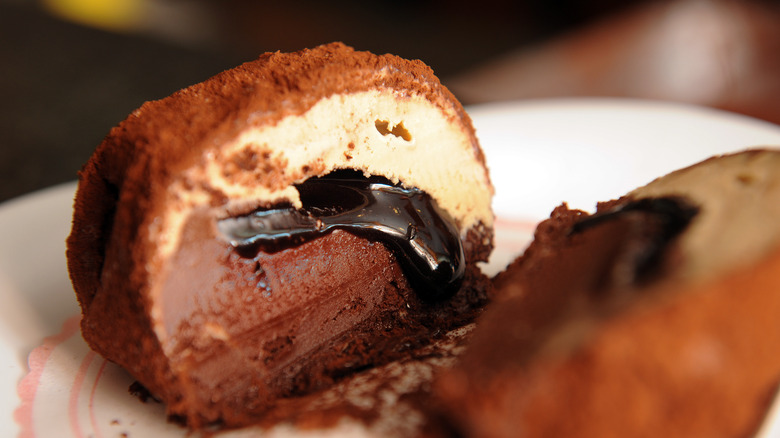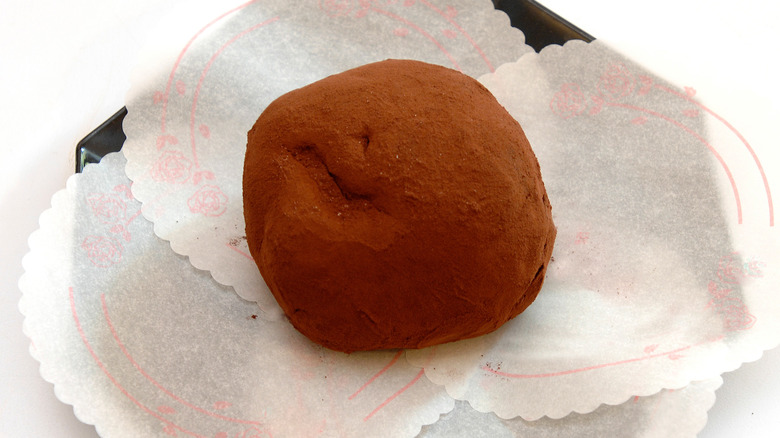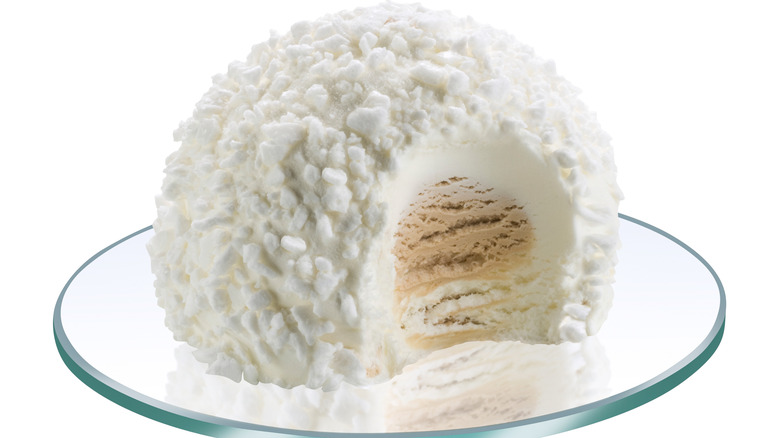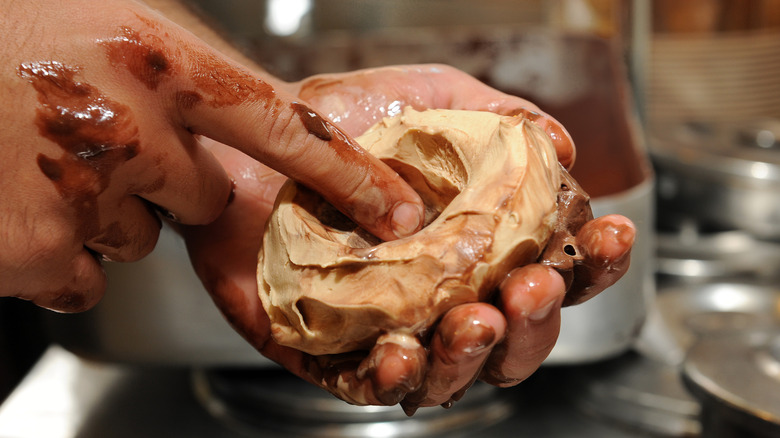Tartufo: Italy's Frozen Dessert That's Inspired By The Truffle
Just like the expensive and rare fungi it's named after, a tartufo is elegant and delicious. Meaning truffle in Italian, the tartufo is a frozen ice cream dessert generally with nuts or fruit at the center. It also has a sweet outer layer made of chocolate cookie crumbs, cocoa powder, or a chocolate shell.
Making a tartufo may sound like it requires the skills of an expert chef or chocolatier, but it's a relatively easy process that can be done at home with just a little time and some creativity. Some of the more common ice cream flavors used to form a tartufo are chocolate, vanilla, pistachio, and hazelnut, but ultimately anything goes. While fairly simple to make, the beautiful appearance of the tartufo makes it appropriate for an upscale gathering, but its appealing quality makes it suitable to be served at children's birthday parties or after Sunday dinner. And let's face it, does anyone ever really need an excuse to enjoy ice cream?
Invented during a dessert emergency
The story goes that the tartufo was first created in the 1950s as a way to still serve dessert at a wedding after the confectioner ran out of gelato cups in the city of Pizzo, which is found in the region of Calabria in southern Italy. Under pressure not to disappoint the wedding guests, Don Pippo decided to take the ice cream, form it into balls, and then roll them in cocoa powder for an outer coating before wrapping them in paper to be served. That first iteration of the tartufo was made of two kinds of ice cream, hazelnut and chocolate.
Other origin stories differ slightly (some say the event was not a wedding but a feast for a new prince), but the same ice cream hero, Don Pippo, is still the creator of the tartufo. Born in Sicily, Pippo likely would have been familiar with making arancini, a rice ball stuffed with sauce and vegetables that are rolled in breadcrumbs and fried. In the case of the tartufo, Pippo opted to use cocoa powder for the outer layer, giving the dessert an appearance similar to the black truffles dug up from the earth. And thus, the tartufo was born.
Limitless variations
There are many variations of tartufo; after all, it simply is two kinds of ice cream with a filling and an outer shell. Some call for vanilla and pistachio ice cream with maraschino cherries in the center. The concoction is then coated with crumbled chocolate wafer cookies and a chocolate shell. Another combination can include chocolate and vanilla ice cream, Amarena cherries, hot fudge, and amaretti cookies that is encased in a chocolate shell that is further topped with crushed hazelnuts.
Cherries at the center of the tartufo are common; Martha Stewart even uses two at the center of her tartufo with chocolate and pistachio ice cream that has been coated with crushed chocolate wafer cookies and finished with a chocolate shell made of melted semisweet chocolate. Ice cream maker Long Island Tartufo sells the dessert in a variety of flavors, such as rainbow cookie, spumoni, peanut butter, and white chocolate Parisienne with a raspberry sorbet center. Ultimately, a tartufo can be made to fit personal tastes or the theme of a gathering.
How to make a tartufo
Personal taste not only determines what ingredients are used to create a tartufo but also its size. Individual or shareable serving methods are both common. Martha Stewart uses a small glass bowl lined with plastic wrap. Each ice cream flavor is packed into one side of the bowl with a cherry placed in an indentation made in each ice cream flavor. The cherry is then covered with more ice cream. Once this stage is completed, it's wrapped in plastic and then put in the freezer for a minimum of two hours or even overnight. After the ice cream is frozen, the cookie crumbles can be lightly pushed into the exterior of the ice cream to form a layer. Then, it needs to be rewrapped and frozen again. Finally, once unwrapped, the tartufo is placed on a wire rack, and chocolate is drizzled over the ball of ice cream to form a shell and then allowed to cool and harden before serving. Or the dessert can be frozen again to be served later.
While Chef Geoffrey Zakarian prefers chocolate cookie crumbles for the outer layer on his tartufo, he says that chocolate shavings or chocolate chips work just as well. He also notes not to worry about the tartufo being a perfect ball because if it has a flat bottom, it is easier to serve in a dish. The key is to have fun, get creative, and make something cool and delicious to savor.



